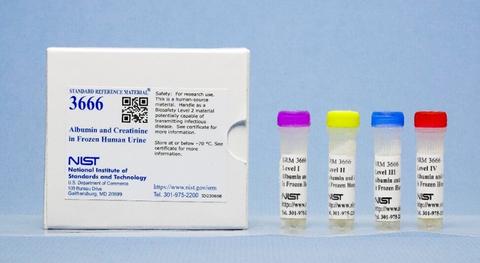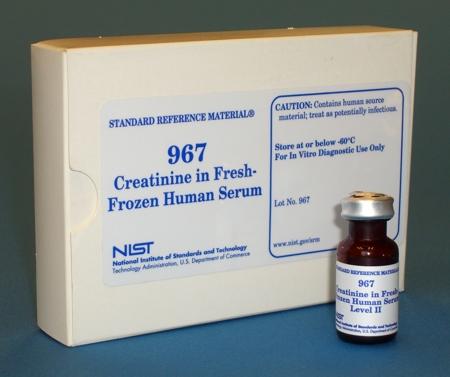Development of Reference Measurement Procedures and Reference Materials for Creatinine
Summary
Chronic kidney disease (CKD) is a growing problem in the U.S., and current estimates suggest that more than 20 million Americans are affected by this disease. If left untreated, kidney disease can eventually lead to kidney failure. At this point, dialysis or kidney transplant are the only options available to sustain life. Early detection of CKD is essential for minimizing the danger of kidney failure. Measurement of serum creatinine levels is the most widespread method for detection of problems in kidney function. In order to improve the accuracy of creatinine measurements, the National Kidney Disease Education Program recommended that a reference material be developed for creatinine in serum and urine. NIST has responded to this need by developing SRM 967a Creatinine in Frozen Human Serum and SRM 3667 Creatinine in Frozen Human Urine.
Description

SRM 3666 Albumin and Creatinine in Frozen Human Urine
Kidney function can be evaluated by determining the glomerular filtration rate (GFR), which provides an estimate of how well the kidneys are removing waste and excess fluid from the blood. The GFR is not measured directly. Instead, a measurement of serum creatinine is performed, and this value is entered into an equation that estimates GFR. Hence, accurate determination of serum creatinine is essential for meaningful estimation of GFR and assessment of kidney function. The National Kidney Disease Education Program (NKDEP) has initiated a creatinine standardization program that is intended to help in-vitro diagnostic (IVD) manufacturers and clinical laboratories address inter-laboratory variations in creatinine measurements. NKDEP has encouraged IVD manufacturers to purchase SRM 967 as part of this standardization program. As a result, SRM 967 was widely adopted by the clinical diagnostics community. SRM 967 was introduced in early 2007, and was superseded by SRM 967a in 2009.
Major Accomplishments
- A Standard Reference Material for creatinine in serum (SRM 967) was developed in collaboration with NKDEP. SRM 967 was certified using isotope dilution-based GC/MS and LC/MS methods, and was issued in early 2007.
- Sales of this SRM approached 150 units within the first year, indicating rapid adoption by the clinical diagnostic community.
- An isotope-dilution LC-MS method was developed as a replacement for the GC-MS method previously used for determination of creatinine.
- SRM 3667 Creatinine in Frozen Human Urine was certified using isotope-dilution LC/MS, and was issued in 2013.
- SRM 967a, developed to mimic SRM 967, superseded SRM 967 in 2009.

Additional Technical Details
SRM 967a consists of frozen human serum with two different levels of creatinine. Level 1 (0.85 mg/dL) is within the normal range of serum creatinine levels, while Level 2 (3.88 mg/dL) is intended to correspond to levels found in chronic kidney disease. The original reference measurement procedure (formerly known as a definitive method) used at NIST for creatinine was based upon isotope dilution gas chromatography-mass spectrometry (GC-MS). This method required multi-step sample preparation as well as derivatization of the analyte prior to quantification. More recently, isotope dilution liquid chromatography-mass spectrometry (LC-MS) has been investigated as an alternative approach to creatinine measurement. Analyte derivatization was not required, and protein precipitation was sufficient to release the analyte of interest. Both GC-MS and LC-MS methods were used to certify SRM 967 Creatinine in Human Serum, and the two techniques provided comparable results. The new LC-MS method is now listed as a higher-order method by the Joint Committee for Traceability in Laboratory Medicine (JCTLM), and was used to certify SRM 967a.
SRM 3667 consists of frozen human urine with one level of creatinine (61.8 mg/dL) within the normal range of urine creatinine levels. A modification of the LC-MS method was used to certify SRM 3667.
Associated Products
ASSOCIATED PUBLICATIONS
1. Wise, S. A., Phinney, K. W., Duewer, D. L., Sniegoski, L. T., Welch, M. J., Pritchett, J., Pabello, G., Calderon, M. A. A., Balderas, M., Liu, Q. D., Kooi, L. T., Rego, E., Garrido, B., Allegri, G., de La Cruz, M., Barrabin, J., Monteiro, T., Lee, H., Kim, B., Delatour, V., Peignaux, M., Kawaguchi, M., Bei, X., Can, Q., Nammoonnoy, J., Schild, K., Ohlendorf, R., Henrion, A., Goren, A. C., Yilmaz, H., Bilsel, M., Konopelko, L., Krylov, A., and Lopushanskaya, E., "CCQM-K11.2 Determination of Glucose in Human Serum and CCQM-K12.2 Determination of Creatinine in Human Serum," Metrologia, 55, (2018).
2. Schantz, M. M., Benner, B. A., Heckert, N. A., Sander, L. C., Sharpless, K. E., Vander Pol, S. S., Vasquez, Y., Villegas, M., Wise, S. A., Alwis, K. U., Blount, B. C., Calafat, A. M., Li, Z., Silva, M. J., Ye, X., Gaudreau, E., Patterson, D. G., and Sjodin, A., "Development of urine standard reference materials for metabolites of organic chemicals including polycyclic aromatic hydrocarbons, phthalates, phenols, parabens, and volatile organic compounds," Analytical and Bioanalytical Chemistry, 407, 2945-2954 (2015).
3. Camara, J. E., Duewer, D. L., Gasca-Aragon, H., Lippa, K. A., and Toman, B., "CCQM-K80 Comparison of value-assigned CRMs and PT materials: creatinine in human serum Final Report," Metrologia, 50, (2013).
4. Camara, J. E., Lippa, K. A., Duewer, D. L., Gasca-Aragon, H., and Toman, B., "An international assessment of the metrological equivalence of higher-order measurement services for creatinine in serum," Analytical and Bioanalytical Chemistry, 403, 527-535 (2012).
5. Dodder, N.G., Tai, S.S-C., Sniegoski, L.T., Zhang, N.F., and Welch, M.J., "Certification of Creatinine in a Human Serum Reference Material by GC-MS and LC-MS," Clin. Chem., 53(9):1694-1699 (2007).
6. Phinney, C. S., Murphy, K. E., Welch, M. J., Ellerbe, P. M., Long, S. E., Pratt, K. W., Schiller, S. B., Sniegoski, L. T., Rearick, M. S., Vetter, T. W., and Vocke, R. D., "Definitive method certification of clinical analytes in lyophilized human serum: NIST standard reference material (SRM) 909b," Fresenius Journal of Analytical Chemistry, 361, 71-80 (1998).

